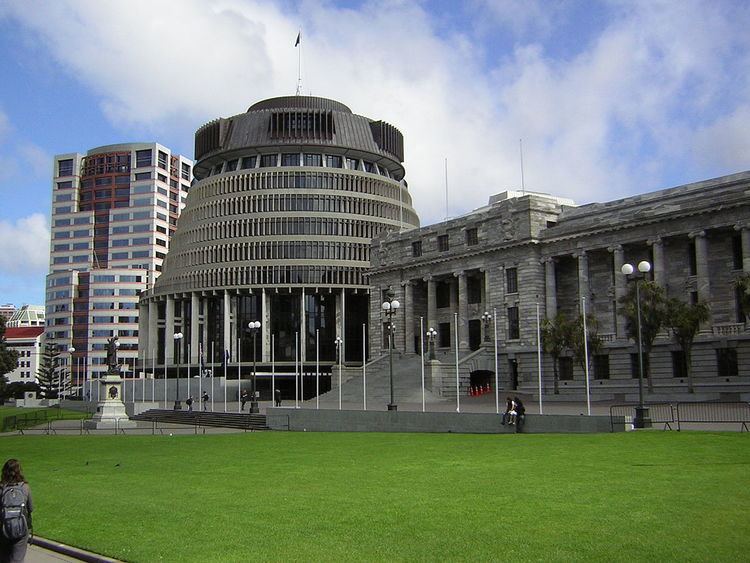Alternative names Beehive, Whare Mīere Completed 1981 Renovated 1998-20062013-2014 Height 72 m | Construction started 1969 Inaugurated May 1977 Opened 1977 | |
 | ||
Owner Government of New Zealand Hours Open today · 9AM–5PMThursday9AM–5PMFriday9AM–5PMSaturday9AM–5PMSunday9AM–5PMMonday9AM–5PMTuesday9AM–5PMWednesday9AM–5PM Similar Museum of New Zealand, Parliament House - Wellington, Wellington Cable Car, Old St Paul's - Wellington, Zealandia | ||
The Beehive is the common name for the Executive Wing of the New Zealand Parliament Buildings, located at the corner of Molesworth Street and Lambton Quay, Wellington. It is so-called because of its shape is reminiscent of that of a traditional woven form of beehive known as a "skep". It is registered as a Category I heritage building by Heritage New Zealand.
Contents
History
Scottish architect Sir Basil Spence provided the original conceptual design of the Beehive in 1964. The detailed architectural design was undertaken by the New Zealand government architect Fergus Sheppard, and structural design of the building was undertaken by the Ministry of Works. The Beehive was built in stages between 1969 and 1979. W. M. Angus constructed the first stage - the podium, underground car park and basement for a national civil defence centre, and Gibson O'Connor constructed the ten floors of the remainder of the building.
Bellamy's restaurant moved into the building in the summer of 1975–76 and Queen Elizabeth II, Queen of New Zealand, unveiled a plaque in the reception hall in February 1977. The Prime Minister, Robert Muldoon, formally opened the building in May 1977. The government moved into the upper floors in 1979. The annex facing Museum Street was completed in 1981.
Renovations were carried out and the interior was modernised between 1998 and 2006 to plans by Christchurch architecture firm Warren and Mahoney. In 2013 and 2014, the roof was repaired and windows replaced.
In July 2015, Heritage New Zealand declared the Beehive "of outstanding heritage significance for its central role in the governance of New Zealand". Blyss Wagstaff of Heritage New Zealand called it "one of the most recognisable buildings in the country. Heritage New Zealand assigned the highest rating for a historic place, Category I, to the building. The original application for the heritage designation was made by Lockwood Smith, a former Speaker of the House of Representatives. The heritage registration with the list number 9629 became effective on 24 July 2015. The tunnel to Bowen House is specifically excluded from the heritage registration.
Facts and figures
The building is ten storeys (72 m) high and has four floors below ground. The entrance foyer's core is decorated with marble floors, stainless steel mesh wall panels, and a translucent glass ceiling.
The Beehive's brown roof is constructed from 20 tonnes of hand-welted and seamed copper. It has developed a naturally weathered appearance. A tunnel leads from the building under Bowen Street, linking the Beehive with parliamentary offices in Bowen House. The Beehive is extensively decorated with New Zealand art. On the inner wall of the Banquet Hall is a large notable mural by John Drawbridge portraying the atmosphere and sky of New Zealand.
The Beehive's circular footprint (see rotunda) is generally considered an elegant and distinctive design feature. However it is also quite impractical, as many of its rooms are wedge-shaped, curved or asymmetrical. An extension has been built out the front to allow for a new security entrance. A new, bomb-proof mail delivery room has already been built at the rear of the building.
The Beehive has, since 1992, featured as part of the design of the New Zealand twenty-dollar note.
Uses
The top floor is occupied by the Cabinet room, with the Prime Minister's offices on the ninth floor (and part of the eighth). Other floors contain the offices of cabinet ministers.
Other facilities within the building include function rooms and a banqueting hall on the first floor of the Beehive, which is the largest function room in the parliamentary complex. The parliamentary catering facilities of Bellamy’s include a bar known as Pickwicks or 3.2 (due to its position in the building on the third floor and second corridor), Copperfield's café, and the Member's and Member's and Guests restaurants. The building also houses, in its basement, the country's National Crisis Management Centre. Other facilities include a theatrette and a swimming pool. The parliament building is used by MPs who hold meetings or are discussing bills or new laws.
Tours
Free guided tours lasting up to one hour are available, as are educational visits for students.
